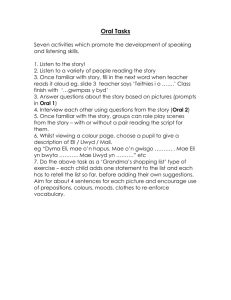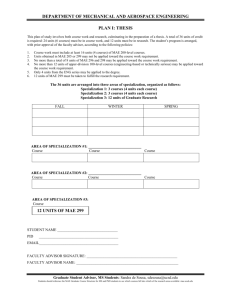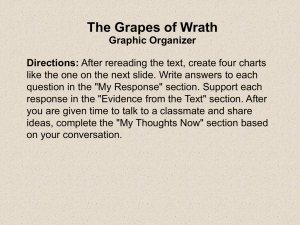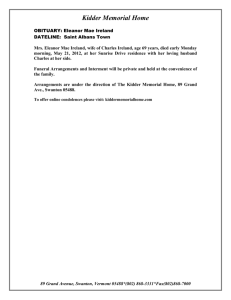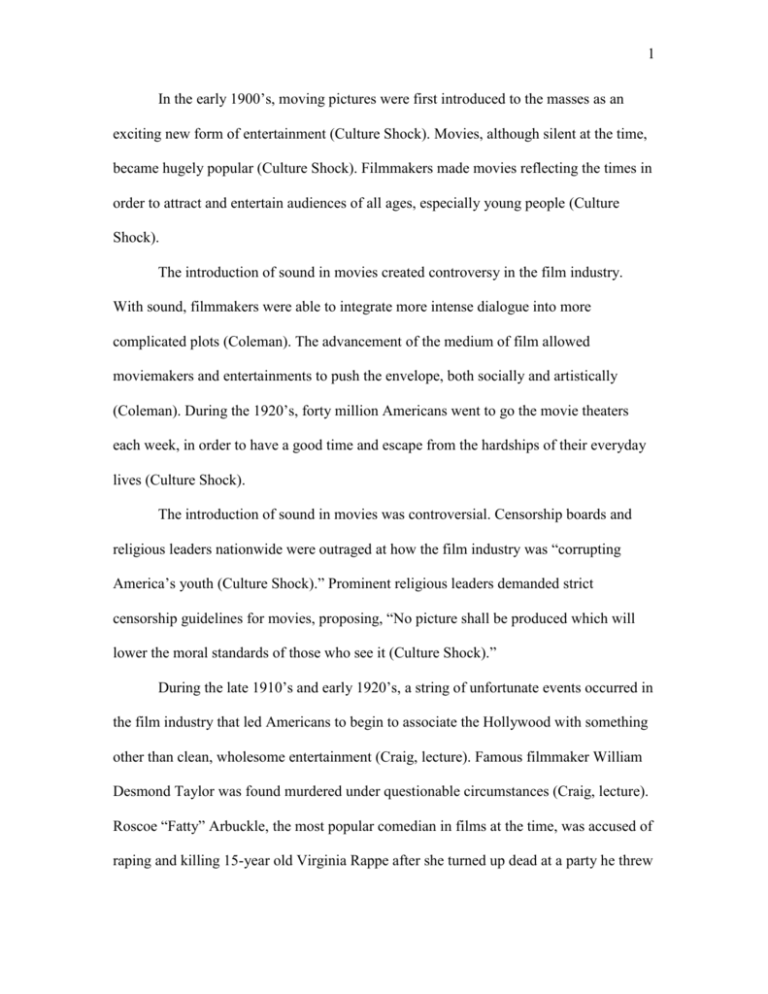
1
In the early 1900’s, moving pictures were first introduced to the masses as an
exciting new form of entertainment (Culture Shock). Movies, although silent at the time,
became hugely popular (Culture Shock). Filmmakers made movies reflecting the times in
order to attract and entertain audiences of all ages, especially young people (Culture
Shock).
The introduction of sound in movies created controversy in the film industry.
With sound, filmmakers were able to integrate more intense dialogue into more
complicated plots (Coleman). The advancement of the medium of film allowed
moviemakers and entertainments to push the envelope, both socially and artistically
(Coleman). During the 1920’s, forty million Americans went to go the movie theaters
each week, in order to have a good time and escape from the hardships of their everyday
lives (Culture Shock).
The introduction of sound in movies was controversial. Censorship boards and
religious leaders nationwide were outraged at how the film industry was “corrupting
America’s youth (Culture Shock).” Prominent religious leaders demanded strict
censorship guidelines for movies, proposing, “No picture shall be produced which will
lower the moral standards of those who see it (Culture Shock).”
During the late 1910’s and early 1920’s, a string of unfortunate events occurred in
the film industry that led Americans to begin to associate the Hollywood with something
other than clean, wholesome entertainment (Craig, lecture). Famous filmmaker William
Desmond Taylor was found murdered under questionable circumstances (Craig, lecture).
Roscoe “Fatty” Arbuckle, the most popular comedian in films at the time, was accused of
raping and killing 15-year old Virginia Rappe after she turned up dead at a party he threw
2
in San Francisco (Craig, lecture). Though Arbuckle went to trial and was acquitted by a
jury, audiences could not look at him and laugh the way they did before, and he was
banned from the film industry (Craig, lecture). Actor Wallace Reid died from a drug
overdose (Culture Shock). These were dark times for Hollywood.
In 1922, the film industry hired former Republican Party Chairman and
postmaster named Will Hays (Fellow, 226). As a press agent, Hays’ job was to boost the
film industry’s tarnished reputation by proving that Hollywood was more than just about
scandal, sex and violence (Culture Shock).
Hays came up with a set of strict guidelines for censorship in films, which the
film studios were advised to follow. This set of rules, which included a list of “Don’ts”
and “Be Carefuls,” came to be known as the “Hays Code (Fellow, 226).” The Code was
officially adopted by the film industry in 1930 (Fellow, 226), after Hays persuaded the
film industry that following the Code was the safest and cheapest solution to handling
their dispute with censorship boards and religious leaders (Culture Shock). The fact that it
was cheap was vital, since the beginning of the Depression era (1929-1931) marked a
huge economic collapse for the movie industry (Culture Shock). The profits of the
industry collapsed during this time by 40% from before the stock market crash of 1929
(Craig, lecture). Many movie studios were knee deep in debt and were desperate to cut
costs any they possible. Following the Code meant they would not have to pay to edit
their films according the censorship boards (Culture Shock). This code continued to
censor Hollywood movie content for the next 20 years (Culture Shock).
The Code censored everything from language to behavior, including anything
relating to sex and crime, two subjects that attracted the most audience attention (Culture
3
Shock). Other subjects that were prohibited from being shown in movies included nudity,
explicit adultery and sex, suggestive dancing, drug use, sexually transmitted diseases,
childbirth, interracial relationships, and the satirizing of religion (Culture Shock).
However, as the Depression passed by, filmmakers began to defy the Hays Code.
In the early 1930’s, many films depicting women using their sexuality to their advantage
were produced. Movies with “bad girls” such as Red Headed Woman starring Jean
Harlow were hits (Culture Shock). During these strict times in the movie industry, there
was one actress who continued to push artistic and social boundaries. Her name was Mae
West.
Mae West was known for her huge personality, witty dialogue spoken with a catlike purr and double entendres loaded with sexuality, most of which she wrote herself
(Felstead). She revolutionized the idea of accepting sexuality in public media by treating
it as a healthy and natural part of life (Felstead). West’s onscreen and onstage
performances transformed the entertainment industry in terms of style, views on sexuality
and America’s view of women. It is a consensus in the entertainment industry that Mae
West was one of the most well-known and influential actresses of her time. Despite the
controversy that surrounded her because of the censorship challenges she faced, she
remains one of Hollywood’s biggest stars of all time (Felstead).
Although Brooklyn native Mae West did not enter the Hollywood scene until her
late 30’s, she began her career in entertainment at an early age (Curry).
By 1907, Mae West was already touring across the country with Vaudeville, a
theatrical show with entertainers performing songs, dances and jokes (Mae West – 1893).
In 1911, Mae West starred in her first Broadway show, A La Broadway (Overview).
4
West’s earliest performances as a teen are said to have been influenced by Vaudeville star
Eva Tanguay and speakeasy owner and burlesque performer Texas Guinan. Both of these
entertainers were known for shocking, sexual songs and catchphrases (Curry). Following
in her mother’s Vaudeville footsteps, West introduced the “shimmy,” a hip swiveling
dance move, in 1913 (Overview). West has stated that she and her mother were extremely
close until she passed and that it took her about three years to get over the depression of
losing her mother (Mae West – Interview with Dick Cavett). Surely her mother’s support
had much to do with West’s confidence and strong convictions.
West first impressed audiences onstage with her role in the Broadway play
Diamond Lil (Mae West – Biography). Diamond Lil was a huge success, and was
performed on Broadway more than 300 times (Mae West – 1893). Soon after appearing
in Diamond Lil, she moved from New York to Hollywood and signed with Paramount
Pictures in 1932 (Mae West - Biography). During the span of her career as a film actress,
Mae West starred in 12 films, including She Done Him Wrong, the 1933 groundbreaking
film version of the play Diamond Lil, in which her character utters the famous words
“Why don’t you come up sometime and see me” to Cary Grant’s character (Mae West
Films). The title of Diamond Lil and the characters’ names were changed so that the play
could be made into the film She Done Him Wrong, since the Hays Office had prohibited
the play from being made into a movie (Mae West – 1893). Because obvious sexual
comments were forbidden according to the Production Code, West had to perfect her sly,
suggestive jokes, which became her trademark. She Done Him Wrong played a factor in
intensifying the enforcement of the Production Code in 1934 because of Mae West’s
portrayal of seductive and risqué Lady “Diamond” Lou (Mae West Films). In the film,
5
West also sings a heavily censored song titled “I Like a Man That Takes His Time (Mae
West Films)” She Done Him Wrong also broke all existing box-office records (Mae West
– Biography) and received an Academy Award Nomination for Best Picture (Overview).
In her next film I’m No Angel, released in 1933, West creates history by reciting
another suggestive line, “When I’m good, I’m very good, but when I’m bad, I’m better
(Mae West Films).” I’m No Angel was nominated an Academy Award for Best Picture as
well (Overview). Although these racy onscreen performances by West brought upon
criticism from religious conservatives in the Catholic League of Decency, West is said to
have saved Paramount Studios from going bankrupt with her successful roles (Mae West
Films). With bawdy films such as She Done Him Wrong, I’m No Angel, Klondike Annie
and Belle of the Nineties (Mae West - Biography), Mae West made her mark in
Hollywood as the single entertainer who most embodied what censorship boards did not
want in movies (Fellow, 226).
In 1934, Joe Breen, a strict Catholic from Philadelphia, was selected to run
Hollywood’s Production Code Administration (PCA) (Culture Shock). Under the
regulation of Breen, who became known as the “One Man Censor” of Hollywood movies
(Craig, lecture), the threat of federal censorship of movies became more intense. Breen
declared that there was “no room on the screen for the vulgar, the cheap and the tawdry”
(Culture Shock). Breen determined that no movies could be released in major theater
chains without first getting a seal of approval by him (Craig, lecture), and the PCA had
the power to demand script changes and fine $25,000 to any filmmakers who released
movies without its review and approval (Culture Shock). Even after Breen’s
implementation of these guidelines, West continued to stir up controversy (Overview).
6
On December 12, 1937, Mae West caused a network radio censorship scandal
when her voice appeared on NBC as the character of Eve, opposite Adam, in a Garden of
Eden skit during The Chase and Sanborn Hour (Murray). West’s voice was only on NBC
for a short 30 minutes and it was her only major radio performance (Murray), but it
rocked the nation. Of course, in true Mae West style, plenty of double entendres were
included, and the in the skit she discussed several subjects that were taboo at the time,
including sexuality and religion (Murray). As a result of West’s controversial radio
performance, NBC banned the mention of her name and the skit from the network, after
being criticized for failing to comply with the censorship guidelines of the time (Murray).
She was declared an “unfit radio personality” and did not appear on the airwaves for 15
years (Murray). Being censored never bothered West and she was not afraid of
highlighting subjects that censorship made taboo. In fact, she enjoyed it. She is famous
for once declaring, “I believe in censorship. After all, I made fortune out of it.” This
quote shows that West was not worried about what anyone thought of her. She never
apologized for being true to herself. Instead, she used her risqué persona to her
advantage. During an interview, West once playfully shared with her interviewer that
often, she would “put things in [movies] that they knew they were going to take out, just
to make them happy (Mae West – Interview with Dick Cavett).”
Because of her racy and suggestive language and behavior, West was considered a
sexual deviant and symbolized the “immoral” reputation of Hollywood to many
conservative Americans (Murray). Her overtly sexual and brash image sharply contrasted
with the American society’s middle-class social ideals of the era, which stated that
women had to be modest and pure (Murray).
7
Although Mae West was notorious for portraying overtly sexual women who
seduced men, that was not her only talent. She was also a talented and shrewd
businesswoman who wrote and produced her own novels and screenplays (Mae West –
Interview with Dick Cavett). The first play that she wrote, titled Sex, was considered so
obscene and shocking that it landed her behind bars for over a week (Mae WestInterview with Dick Cavett). Many media outlets were offended by the play and some
newspapers refused to even run an advertisement for it (Mae West- Interview with Dick
Cavett). It only brought West more media attention when she was accused for “corrupting
the morals of youth” and sent to jail after writing the play Sex (Bird). This skyrocketed
her career and took her provocative reputation to a whole new level. West stated that she
actually appreciated her time in jail because it was a learning experience. She was later
able to create characters for her screenplays influenced by real people she met in jail
(Mae West – 1893).
Once during an interview, when the interviewer said that he felt everything she
says has at least three meanings, she laughed and responded, “Well, that’s my mind (Mae
West – Interview with Dick Cavett).” Her quick and witty intelligence is perhaps what
allowed West to write and come up with so many of her own double-entendre phrases,
such as “Is that a gun in your pocket or are you just happy to see me?”
The way West embraced her sexual nature certainly played a key role in her
success. She was involved in many romantic relationships with men and is noted for once
stating, “All types of men…The man I don’t like doesn’t exist, I’m afraid,” when a radio
interviewer asked her what her favorite type of man is (West). As much as West enjoyed
the company of the opposite sex, she refused to be defined by her relationships with men.
8
She was first and foremost a confident, independent woman who knew that it is
impossible to love anyone else without loving yourself first. She once stated, “I’m my
own original creation. I concentrate on myself most of the time; that’s the only way a
person can become a star in the true sense. I never wanted a love that meant surrender of
my self-possession. I saw what it did to other people when they loved another person the
way I loved myself, and I didn’t want that problem. I had to stay in command of my
career.”
It was this confident and independent mindset that allowed West to become so
successful, despite the censorship boards’ and media’s objection to her controversial
works. By the 1930’s, West was the eighth largest box office attraction and the second
highest paid person in the entire nation, just after William Randolph Hearst (Bird). This
speaks to the fact that she was a female powerhouse. She climbed her way to the top of
the male dominated career ladder, during the time this was unheard of.
Mae West remains wildly influential today. A prime example that proves this is a
newspaper article headline from August 15, 1993 that declared “Mae West Remains Hot
Number (Curry).” The article underneath the headline included details for upcoming
events celebrating 100 years since West’s birth. Some of the events included film
screenings, costume and photography exhibits, and a female impersonator’s performance
at a Los Angeles museum (Curry). Another article published on August 15, by the New
York Times, announced the release of West’s films from the 1930’s on videotape
(Curry).
Since West’s death in 1980, four biographies have been written and released, two
biographical films have been broadcasted on national television, and at least two murder
9
mysteries featuring West as a central character have been released (Curry). Specialty
bookstores and music stores often carry recordings of West’s radio, television and
musical performances, and memorabilia stores nationwide continue to sell collectables
depicting West, such as posters and cards (Curry).
West was an advocate of gay rights and remains a gay cult figure (Curry). West
believed that “a gay man is a female soul housed in a male body (Overview).” In 1927,
she wrote the play The Drag about homosexuality, a play that was so controversial, no
New York theaters including Broadway wanted to play it (Curry). In a television
interview, she once responded to the interviewer’s statement “Gays love you,” by stating
“Well, they knew what I was doing for them! (Mae West – Interview with Dick Cavett)”
Mae West was, and is, a social phenomenon that played a vital role in the
censorship laws in Hollywood and the way women were viewed. As a confident, strong
female actress and an early supporter of the Women’s Liberation Movement (Bird), Mae
West paved the way for not only women in show business, but all women to feel free to
speak their minds. West once stated, “You only live once, but if you do it right, once is
enough” (Bird). She certainly led a life unlike any other. She was a woman who knew
what she wanted and knew how to get it, and because of this she was able to use the
media to control her own image. Her contributions toward women’s rights and equality in
society as the entertainment industry are unparalleled. Mae West and her brazen
confidence can be largely credited for the success of many of today’s female
entertainments in film and music. West was a pioneer and an innovator, and will remain
an icon and inspiration for years to come.
10
Works Cited
Bird, Jessica. "Mae West Inspiring Woman | White Water Women."
Whitewaterwomen.com. White Water Women. Web. 08 Nov. 2011.
<http://www.whitewaterwomen.org/wonderful-women/from-history/mae-west1893-1980/>.
Coleman, Breanna. "How the Film Production Code of 1930 Censored America |
Suite101.com." Brenna Coleman | Suite101.com. 1 July 2010. Web. 08 Nov.
2011. <http://brennacoleman.suite101.com/how-the-film-production-code-of1930-censored-america-a243222>.
Craig, Richard. Lectures in Mass Communications 103, Aug. – Nov.2011
"Culture Shock: The TV Series and Beyond: Hollywood Censored: The Production
Code." Pbs.org. Public Broadcasting Service. Web. 08 Nov. 2011.
<http://www.pbs.org/wgbh/cultureshock/beyond/hollywood.html>.
Curry, Ramona. Too Much of a Good Thing: Mae West as Cultural Icon. Minneapolis:
University of Minnesota, 1996.
Fellow, Anthony R. American Media History. Boston: Wadsworth/Cengage Learning,
2010. Print.
11
Felstead, Anna-Louise. "Hollywood Women Part 1: Icons." Orsonwelles.co.uk. Web. 08
Nov. 2011. <http://www.orsonwelles.co.uk/HollywoodWomen1.htm>.
"Film History: Undershirts, Scandals and a Depression." Cybercollege.com. Cyber
College, 5 July 2011. Web. 08 Nov. 2011.
<http://www.cybercollege.com/frtv/frtv004.htm>.
Large, Victoria. "Tough As Diamonds: Taboos, Censorship and Mae West | Brattle
Theatre Film Notes." Brattle Theatre Film Notes | A Series of Periodic Film
Commentaries Presented by the Brattle Film Foundation. Web. 08 Nov. 2011.
"Mae West Collection | Old Time Radio." Old Time Radio Catalog: Classic
Radio | Golden Age of Radio -. Web. 08 Nov. 2011. <http://www.otrcat.com/maewest-collection-p-48497.html>.
"Mae West, 1893-1980: The Wild Woman of Film and Stage | Special English | Learning
English." News | English. Web. 08 Nov. 2011.
<http://www.voanews.com/learningenglish/home/a-23-2008-11-22-voa283138367.html>.
"Mae West - Biography on Bio." Bio: Shows, Video, TV Schedule and More on Bio. Web.
08 Nov. 2011. <http://www.thebiographychannel.co.uk/biographies/maewest.html>.
12
"Mae West Films | Mae West Filmography | Mae West Biography | Mae West Career |
Mae West Awards." Film Director | Movie Director | Film Directors | Movie
Directors | Filmmaker | FilmDirectorsSite.com | Directing | Filmmaker |
Filmmaking | Filmmaker | Film from Director | Director Film. Web. 08 Nov.
2011. <http://www.filmdirectorssite.com/mae-west>.
"Mae West - Interview with Dick Cavett - YouTube." YouTube - Broadcast Yourself. 8
Sept. 2010. Web. 08 Nov. 2011.
<http://www.youtube.com/watch?v=WsL7AHCM7PU>.
Murray, Matthew. Mae West and the Limits of Radio Censorship in the 1930's. Colby
Quarterly.
"Overview for Mae West." Tcm.com. Turner Classic Movies. Web. 8 Nov. 2011.
<http://www.tcm.com/tcmdb/person/204532%7C103917/Mae-West/>.
"Sex in Cinema: Greatest and Most Influential Erotic / Sexual Films and Scenes."
Greatest Films - The Best Movies in Cinematic History. Web. 08 Nov. 2011.
<http://www.filmsite.org/sexinfilms6.html>.
West, Mae, perf. Mae West on Men, Women and Diamonds. Http://www.his
Tory.com/audio/mae-west-on-men-women-and-diamonds#mae-west-on-menwomen-and-diamonds. History Channel. Web. 8 Nov. 2011.

